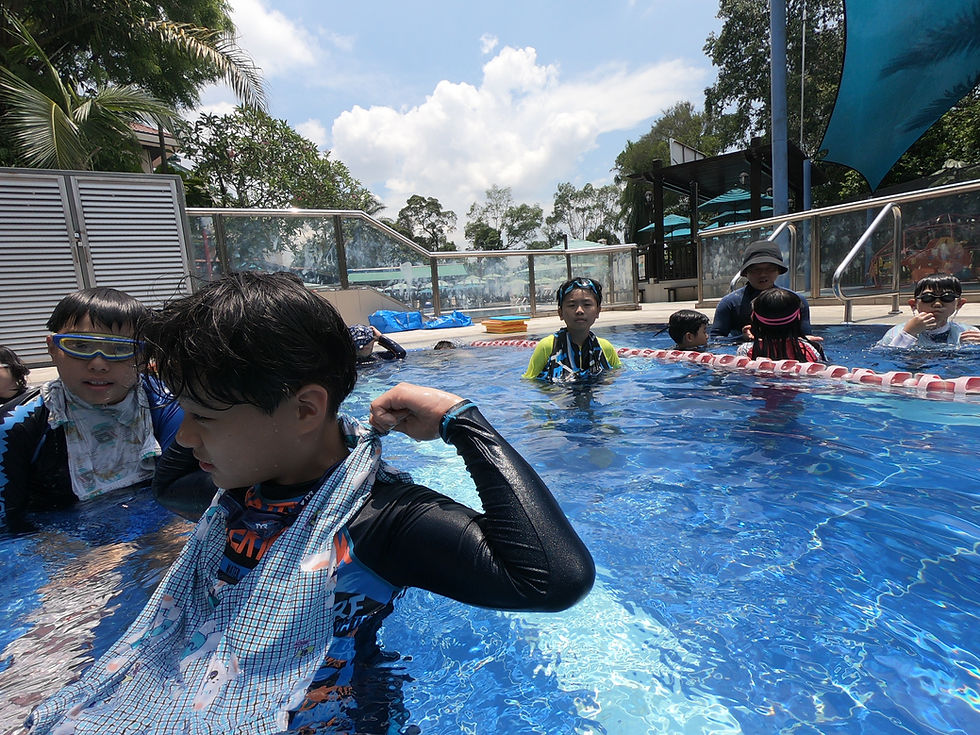How to Use Landmarks for Navigation During Open Water Swims
- SG Sink Or Swim

- May 26, 2025
- 3 min read

Open water swimming offers freedom and challenge—but it also removes many of the visual cues that pool swimmers rely on. Without lane lines, walls, or a black line on the pool floor, swimmers must learn to navigate using landmarks to swim straight, maintain pace, and stay on course.
Whether you’re training for a triathlon, open water race, or recreational long-distance swim, understanding how to use landmarks effectively is a critical open water skill that can make your swims faster, safer, and more enjoyable.
🧭 Why Navigation Matters in Open Water
Inaccurate navigation leads to:
Swimming extra distance (zig-zagging instead of swimming straight)
Wasted energy and slower times
Increased anxiety from disorientation
Risk of drifting off course or into unsafe areas
By learning to identify and swim toward fixed visual references—known as landmarks—you can stay aligned and confident in open water environments like lakes, rivers, and oceans.
👀 What Makes a Good Landmark?
Choose objects that are:
Tall and visible from a distance (buildings, trees, buoys, towers)
Stationary and above the waterline (not other swimmers or boats)
High contrast (e.g., a white flagpole against a dark hill)
Unlikely to blend in with the background as you approach
💡 Pro tip: Have both a primary and a backup landmark in case your view is obstructed.
🏊♂️ How to Use Landmarks for Open Water Navigation
✅ 1. Plan Your Route in Advance
Scout the course or shoreline before entering the water.
Pick a landmark that aligns with your swim path.
Identify midpoint markers for longer swims to check your direction.
Note exit points and safety zones (like docks, flags, or lifeguards).
✅ 2. Practice Sighting with Landmarks
Sighting is the technique of briefly lifting your head forward during the swim to visually check your direction.
How to Practice:
Every 6–10 strokes, lift your eyes just above the water line.
Glance at your landmark without disrupting your stroke too much.
Breathe to the side afterward to conserve energy and reset your rhythm.
💡 Try combining sighting with breathing every few cycles (e.g., “breath-breath-sight” pattern).
✅ 3. Line Up with Background Layers
Look beyond your immediate landmark. Use layers of terrain to help navigate:
A tree behind a buoy
A mountain peak aligned with a dock
A light post between two buildings
This adds depth perception and prevents losing your reference as you swim closer.
✅ 4. Practice Landmark Use During Pool Training
Simulate sighting in the pool:
Place cones or objects at the far end of the pool.
Practice lifting your head every 6–8 strokes to spot the object.
Work on maintaining straight-line swimming while sighting.
✅ This builds muscle memory for efficient sighting without major stroke disruption.
✅ 5. Adapt Landmarks Based on Conditions
In wavy or low-light conditions, smaller landmarks may become invisible.
On cloudy days, use high-contrast, large landmarks.
If swimming into the sun, pick landmarks not directly in the glare path.
In choppy conditions, increase sighting frequency to avoid drift.
✅ 6. Use Water-Level Markers for Short-Distance Adjustments
While above-water landmarks help with long-range navigation, water-level cues (like buoys or kayaks) can guide shorter distance adjustments, especially near turns or finishes.
🧠 Tips for Better Navigation
✅ Bilateral breathing helps keep your orientation balanced.
✅ Swim with a tempo that includes sighting built into your rhythm.
✅ Practice “closed-eye” swimming in the pool to build straight-line control.
✅ Use swim watches or GPS to review your navigation path post-swim.
🏁 Final Thoughts
Learning to use landmarks effectively transforms you from a pool-dependent swimmer into a confident open water athlete. With the right sighting habits and strategic landmark selection, you'll swim straighter, conserve energy, and perform better in races or long-distance swims.





Comments